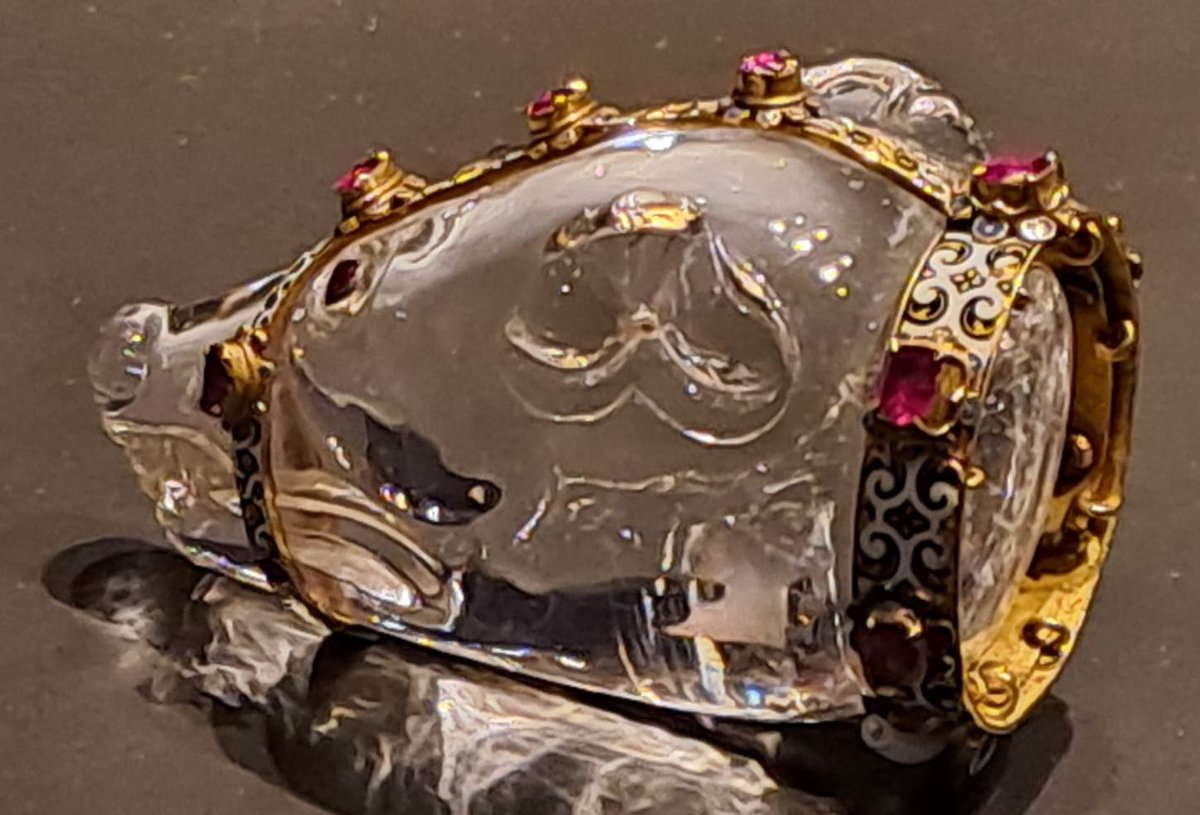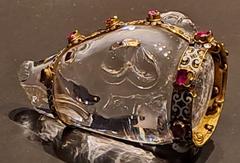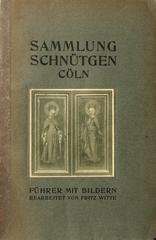
Schnütgen Museum Cologne: Visiting Hours, Tickets, and Guide to Historical Sites
Date: 14/06/2025
Introduction
Set in the heart of Cologne within the Romanesque Church of St. Cecilia, the Schnütgen Museum is a premier destination for those passionate about medieval art and religious history. Founded on Alexander Schnütgen’s remarkable collection, the museum offers a unique blend of spiritual context, architectural heritage, and more than 2,000 medieval objects ranging from sculptures and stained glass to illuminated manuscripts and textiles. This detailed guide covers everything: visiting hours, ticketing, accessibility, highlights from the collection, and tips to enhance your visit to one of Europe’s most significant medieval art museums. For official updates, visit the Schnütgen Museum website and consult travel resources such as Lonely Planet.
Table of Contents
- History and Significance
- Visiting Information (Hours, Tickets, Access)
- Highlights of the Collection
- Guided Tours & Special Exhibitions
- Accessibility & Visitor Tips
- Nearby Attractions
- Digital & Remote Engagement
- Frequently Asked Questions (FAQ)
- Conclusion
- Sources
History and Significance
Origins and Foundation
The Schnütgen Museum began with the vision of Alexander Schnütgen (1843–1918), a Catholic priest devoted to preserving medieval ecclesiastical art. His collection, focused on the Rhineland and neighboring regions, includes sculptures, reliquaries, textiles, manuscripts, and stained glass. In 1906, Schnütgen donated his collection to the city of Cologne, which soon outgrew its initial home and moved in 1910 to the 12th-century St. Cecilia’s Church (Museum Schnütgen).
Institutional Development
In 1932, the museum became an autonomous institution. Under director Fritz Witte, it pioneered a modern, uncluttered display style, emphasizing clarity and individual engagement with each object—a stark contrast to the era’s traditional, crowded presentations (Cambridge Repository). This curatorial approach influenced museums across Germany and Europe.
Collection Growth and Scholarship
With over 2,000 objects on display and more in storage, the Schnütgen Museum’s collection is internationally significant. Highlights include the “Virgin of Cologne,” the monumental “Crucifix of St. George,” and intricately carved altarpieces. Many works are unique survivals, offering insights into medieval religious and artistic life. The museum’s research and exhibitions, such as “Fragmented Devotion: Medieval Objects from the Schnütgen Museum, Cologne,” have enhanced its scholarly reputation (Internet Archive).
Architectural Context and Renovations
St. Cecilia’s Church, dating from the 12th century, provides an authentic Romanesque setting. Early 21st-century renovations added a modern extension and new entrance, blending historic and contemporary architecture while providing advanced conservation and exhibition facilities (Museum Schnütgen).
Place in Cologne’s Cultural Landscape
The Schnütgen Museum is a cornerstone of Cologne’s museum quarter, alongside institutions like Museum Ludwig and the Wallraf-Richartz Museum. It offers permanent and temporary exhibitions, workshops, and public programs, supported by organizations such as the Friends of Museum Schnütgen (Museum Schnütgen).
Significance in Medieval Art
Renowned for its focus on religious objects, the museum’s collection spans the Romanesque through the Gothic period. Its modern display techniques invite visitors to appreciate both the aesthetic and spiritual dimensions of medieval art, setting benchmarks adopted by other museums (Cambridge Repository).
Visiting Information
Opening Hours
- Tuesday–Sunday: 10:00 AM to 6:00 PM
- Thursday: Extended hours until 8:00 PM (until 10:00 PM on the first Thursday of each month)
- Closed: Mondays and major holidays (Museum Schnütgen)
Tickets & Admission
- Adults: €7
- Reduced (students, seniors): €4
- Children under 18: Free
- Combination ticket (with Rautenstrauch-Joest-Museum): €10 (reduced €7)
- Tickets are available on-site and online. Advance booking is advised, especially for guided tours.
Location & Getting There
- Address: Cäcilienstraße 29–33, 50667 Cologne
- Public Transport: Nearest tram stop is “Heumarkt” (lines 1, 7, 9). The museum is a short walk from Köln Hauptbahnhof (main train station). Nearby parking is available but limited (Lonely Planet).
Highlights of the Collection
Medieval Sculpture
- Wood: Expressive Madonnas, saints, and the iconic Cross of St. George (11th century), a Romanesque masterpiece noted for its emotional power (The Crazy Tourist).
- Stone: Romanesque capitals and the tympanum of St. Cecilia’s Church, integrated into the exhibition (WhichMuseum).
- Ivory: Delicate diptychs and devotional objects.
Altarpieces & Religious Furnishings
- Gothic altarpieces with painted panels and sculpted figures.
- Wooden and bronze Madonnas showcase Marian iconography’s evolution.
Stained Glass
- Panels from the 13th–16th centuries, primarily from Cologne’s churches, highlight medieval glass artistry (WhichMuseum).
Goldsmithery & Precious Objects
- Reliquaries, chalices, and liturgical vessels, including Byzantine and Ottonian works, reveal the opulence and technical mastery of Cologne’s medieval church (The Crazy Tourist).
Textiles & Ecclesiastical Vestments
- Embroidered vestments, altar frontals, and banners, notable for their fine materials and iconography (WhichMuseum).
Manuscripts
- Illuminated psalters, missals, and antiphonaries from Cologne’s scriptoria, reflecting the city’s scholarly heritage (The Crazy Tourist).
Chronological & Thematic Arrangement
- Exhibits are organized by period and theme, illustrating artistic development from Romanesque simplicity to Gothic expressiveness and highlighting topics like Marian devotion and the cult of saints (WhichMuseum).
Broader European Connections
- The collection includes Byzantine icons, Baroque sculptures, and select later works, demonstrating the extended influence of medieval forms (WhichMuseum).
Guided Tours & Special Exhibitions
- Guided Tours: Regularly offered in German; English tours by arrangement. Advance booking is recommended for groups.
- Special Exhibitions: The museum hosts thematic shows and participates in city-wide events like the “Long Night of Museums.”
- Educational Programs: Workshops and interactive materials are available for families and school groups (Museum Schnütgen).
Accessibility & Visitor Tips
- Wheelchair Access: Main entrance and galleries are accessible; elevators and accessible restrooms are provided.
- Photography: Generally permitted without flash; some restrictions may apply.
- Visitor Services: Cloakroom, lockers, and a museum shop on site. Numerous cafés are located nearby.
- Recommended Visit Duration: 1.5–2 hours.
- Language: Some signage is only in German; consider using translation apps or preparing in advance (WhichMuseum).
- Quiet Reflection: The museum’s tranquil atmosphere is ideal for contemplative visits.
Nearby Attractions
- Cologne Cathedral (Kölner Dom): UNESCO World Heritage site.
- Museum Ludwig: Modern art, including works by Picasso and Warhol.
- Wallraf-Richartz Museum: Medieval to Impressionist art.
- Old Town (Altstadt): Historic area with shops and cafés.
- Rautenstrauch-Joest-Museum: World cultures, adjacent to the Schnütgen Museum.
Digital & Remote Engagement
- Virtual Tour: Explore the collection online via a 360-degree tour.
- Social Media: Follow the museum on Facebook and Instagram for updates and behind-the-scenes content.
- Audiala App: Enhance your visit with interactive guides and exclusive content.
Frequently Asked Questions (FAQ)
Q: What are the Schnütgen Museum’s visiting hours?
A: Tuesday–Sunday, 10:00 AM–6:00 PM; Thursday until 8:00 PM (10:00 PM on the first Thursday monthly). Closed Mondays.
Q: How much are tickets?
A: Adults €7, reduced €4, free for under 18s. Combination ticket with Rautenstrauch-Joest-Museum: €10 (reduced €7).
Q: Is the museum accessible for wheelchair users?
A: Yes, with elevators and accessible restrooms.
Q: Are guided tours available in English?
A: Yes, by prior arrangement.
Q: Can I take photos inside?
A: Photography without flash is generally allowed; restrictions may apply for specific exhibitions.
Q: Where is the museum located?
A: Cäcilienstraße 29–33, Cologne, near Heumarkt tram stop.
Q: Is there an on-site café?
A: No, but many options are nearby in the city center.
Conclusion
The Schnütgen Museum stands as a beacon of medieval art and heritage, combining a historically rich collection with an evocative Romanesque setting. With accessible facilities, engaging exhibitions, and proximity to Cologne’s other cultural landmarks, it is an essential stop for art lovers and travelers alike. For updates on exhibitions, tickets, and digital offerings, consult the official website and stay connected via social media.
Enhance your experience with the Audiala app for guided tours and exclusive content. Don’t miss the chance to explore Cologne’s medieval treasures both in person and online.
Sources
- Schnütgen Museum official website
- Museum Schnütgen
- The Crazy Tourist: 25 Best Things to Do in Cologne
- WhichMuseum: Schnütgen Museum
- Lonely Planet: Museum Schnütgen
- GPSmyCity: Schnütgen Museum
- Fragmented Devotion: Medieval Objects from the Schnütgen Museum, Cologne
- Cambridge Repository: Museum Schnütgen Display Innovations







































































